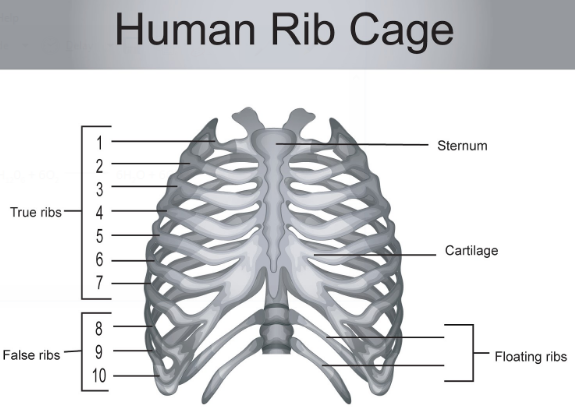
What is a true rib, a false rib, a floating rib? Why are floating ribs easily broken?
Answer
521.1k+ views
Hint: Human ribs are flat bones that form part of the rib cage to help to protect internal organs. Most of the ribs are joined to the sternum at the front of the body by the costal cartilage. The ribs are of various types that include true ribs, false ribs, floating ribs, etc.
Complete answer:
In our body 33 ribs are present. Every rib is flat, and thin and is found to be connected to the vertebral column dorsally while ventrally it is connected to the sternum. It is called bicephalic because it has two surfaces with articulations on its dorsal end.
The true ribs are seven pairs in number and they are known as true ribs because they are attached to the thoracic vertebrae dorsally while it is attached to the sternum ventrally associated with the sternum via ligament.
The false ribs are three in number and are intermediate between the true ribs and the false ribs and are also called the vertebrochondral ribs. The Vertebrochondral ribs are from the eighth-to-twelfth pair of ribs. The ribs from ${ 8 }^{ th }$ to ${ 10 }^{ th }$ pairs do not connect directly to the sternum and are connected through the costal cartilages of the ribs above them. They vary from the false ribs as they do not connect directly with the sternum instead but connect the seventh rib via the hyaline cartilage. In this group of false ribs, the floating ribs are also included in this group thus making five pairs of false ribs.
The floating ribs consist of two sets and are not connected with the sternum or the cartilaginous tissue of other ribs. They are the numbers 11 and 12 located at the posterior end with articulations. They are also called vertebral ribs because they are connected with muscles of the body wall situated in the lateral region.
The floating ribs can be easily broken because they are attached to the vertebrae in only one place and their tissues that connect them with the bones are very thin while their other end is free from attachment.

Note:
Each rib consists of a head, neck, and shaft. In males, the rib cage is expanded during puberty due to the presence of testosterone. Thus, males have broad shoulders and expanded chests, this helps them to inhale more air and supply more oxygen to their muscles. The number of ribs may sometimes vary. It is found that 1 in 200-500 people have cervical rib which is additional.
Complete answer:
In our body 33 ribs are present. Every rib is flat, and thin and is found to be connected to the vertebral column dorsally while ventrally it is connected to the sternum. It is called bicephalic because it has two surfaces with articulations on its dorsal end.
The true ribs are seven pairs in number and they are known as true ribs because they are attached to the thoracic vertebrae dorsally while it is attached to the sternum ventrally associated with the sternum via ligament.
The false ribs are three in number and are intermediate between the true ribs and the false ribs and are also called the vertebrochondral ribs. The Vertebrochondral ribs are from the eighth-to-twelfth pair of ribs. The ribs from ${ 8 }^{ th }$ to ${ 10 }^{ th }$ pairs do not connect directly to the sternum and are connected through the costal cartilages of the ribs above them. They vary from the false ribs as they do not connect directly with the sternum instead but connect the seventh rib via the hyaline cartilage. In this group of false ribs, the floating ribs are also included in this group thus making five pairs of false ribs.
The floating ribs consist of two sets and are not connected with the sternum or the cartilaginous tissue of other ribs. They are the numbers 11 and 12 located at the posterior end with articulations. They are also called vertebral ribs because they are connected with muscles of the body wall situated in the lateral region.
The floating ribs can be easily broken because they are attached to the vertebrae in only one place and their tissues that connect them with the bones are very thin while their other end is free from attachment.

Note:
Each rib consists of a head, neck, and shaft. In males, the rib cage is expanded during puberty due to the presence of testosterone. Thus, males have broad shoulders and expanded chests, this helps them to inhale more air and supply more oxygen to their muscles. The number of ribs may sometimes vary. It is found that 1 in 200-500 people have cervical rib which is additional.
Recently Updated Pages
Master Class 11 Economics: Engaging Questions & Answers for Success

Master Class 11 English: Engaging Questions & Answers for Success

Master Class 11 Social Science: Engaging Questions & Answers for Success

Master Class 11 Biology: Engaging Questions & Answers for Success

Class 11 Question and Answer - Your Ultimate Solutions Guide

Master Class 11 Business Studies: Engaging Questions & Answers for Success

Trending doubts
10 examples of friction in our daily life

One Metric ton is equal to kg A 10000 B 1000 C 100 class 11 physics CBSE

Difference Between Prokaryotic Cells and Eukaryotic Cells

1 Quintal is equal to a 110 kg b 10 kg c 100kg d 1000 class 11 physics CBSE

State the laws of reflection of light

Explain zero factorial class 11 maths CBSE




